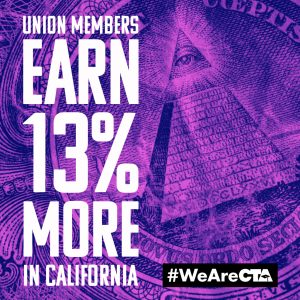CalPERS current rate of return – is 18.4%.
SB 1458 – was signed into law by the Governor in 2012 to alter the structure of the Academic Performance Index (API), changing the criteria by which schools are held accountable. The state’s main measure of a high school’s performance shifted from a near reliance on state test scores to a broader gauge of student accomplishment and preparation for college and career readiness. In essence, the law makes changes to the composition and use of the API. Scheduled to take effect in 2016, these ambitious changes, including any additional elements, cannot go into effect until one year after adoption by the State Board of Education (SBE).
CTA State Council voted to work with lawmakers in Sacramento to delay the use of the API until 2017 to give teachers a full year of teaching common core standards, working with new interim assessments and developing competency for using Smarter Balanced Digital Library resources.
AB 484 update – this was meant to provide an assessment system of assessments of pupils that has the primary purposes of assisting teachers, administrators, and pupils and their parents; improving teaching and learning; and promoting high-quality teaching and learning using a variety of assessment approaches and item types.
What has been done?
• Sunset those provisions of law governing the development of the Standardized Testing and Reporting (STAR) Program as of July 1, 2014.
• Established the California Assessment of Student Performance and Progress (CAASPP) System as the pupil assessment system to replace the STAR program. Made the CAASPP assessments inoperative on July 1, 2021, and will repeal the CAASPP on January 1, 2022, unless legislative action is taken to extend the operative date
What remains to be done?
The state MUST adopt a coordinated testing program that does all of the following:
• Develop and adopt a set of statewide academically rigorous content standards in all major subject areas and produce performance standards for each subject area;
• Provide information and resources to schools and LEAs to assist with the selection of local benchmark assessments, diagnostic assessments, and formative tools aligned with the state- adopted California academic content standards;
• Ensure that all assessment procedures, items, instruments, scoring systems, and results meet high standards of statistical reliability and validity, and that they do not use procedures, items, instruments, or scoring practices that are racially, culturally, socioeconomically, or gender biased;
• Provide information to pupils, parents and guardians, teachers, schools, and local educational agencies on a timely basis so the information can be used to further the development of the pupil or to improve the educational program;
• Require the SBE to adopt regulations that outline a calendar for delivery and receipt of summative assessment results at the pupil, school, grade, district, county, and state levels. Require these regulations to provide for the timely return of assessment results, consider the amount of paper-and-pencil administered assessments, and the number of items requiring hand scoring.
CTA supports the following bills:
• AB 30 (Alejo) D-30 Establishes the California Racial Mascots Act to prohibit public schools in California from using the term “Redskins” as a school or athletic team name, mascot, or nickname.
• AB 80 (Campos) D-27 Creates an Interagency Task Force on the Status of Boys and Men of Color, a multiagency advisory body to serve as a support mechanism for department agency and systems leaders by taking coordinated action in meeting the myriad of challenges facing boys and men of color in California.
• AB 11 (Gonzalez) D-80 Grants paid sick leave to providers of in-home support services.
• SB 3 (Leno) D-11 Increases minimum wage in California to $11 per hour beginning in January 2016, $13 per hour in July 2017, and beginning in January 2019, the statewide minimum wage would be increased annually based on the rate of inflation.
• SB 26 (Hernandez) D-22 Establishes the California Health Care Cost and Quality Database; requires health plans, insurers, and providers to disclose information to implement the database; requires the database by January 1, 2019, to make publicly available a web-based, searchable database and requires the information to be presented in a way so as to facilitate comparisons of cost, quality, and satisfaction.
• SJR 1 (Beall) D-15 Requests the President and the Congress of the United States to pass legislation repealing the Government Pension Offset and the Windfall Elimination Provisions from the Social Security Act. SJR 1 requests the President and the Congress to enact the Social Security Fairness Act, which would repeal the Government Pension Offset and the Windfall Elimination Provisions from the Social Security Act. Members are encouraged to submit letters of support to their legislators using the resources at http://www.nea.org/home/16827.htm.
• AB 141 (Bonilla) D-14 Prohibits a local education agency from charging a fee to a beginning teacher to participate in an induction program and requires school districts and county offices of education to provide an induction program to newly hired beginning teachers commencing with the 2016- 17 school year, and each year thereafter.
• CTA is watching SB 62 (Pavley) D-27 Requires the State Department of Education, in conjunction with the Student Aid Commission, to report to the Legislature on or before January 1, 2017, on the need for the Assumption Program of Loans for Education, needed improvements to increase the supply of high-quality teachers for high-needs schools and the need to establish new recruitment and financial aid programs to accomplish that objective.
Significant Drops in Suspensions and Expulsions for Second Year in a Row – State Superintendent of Public Instruction Tom Torlakson today announced a dramatic 20 percent drop in the number of students expelled in 2013-14 and a 15.2 decline in the number of students suspended. This marks the second year in a row of declines in both areas. The new figures come at a time when the California Department of Education (CDE) is working with districts around the state to implement innovative programs that reduce suspensions and expulsions, including some known as “restorative justice.” These programs address specific behavioral issues which can lead to suspensions and expose pupils to positive activities and behaviors.
“These numbers show that the work of the department, districts, teachers, parents, and students around the state is paying off by keeping more students in school and learning,” said Torlakson. “You can have the best facilities, the best teachers, and the best curriculum in the world, but none of that matters if students are not in school. That’s why we have put so much effort into increasing school attendance and reducing expulsions and suspensions and will continue to do so.”
Read Across America and California Reads program – is in full swing and the Committee is promoting and selecting books based on diversity, books in English and Spanish, and books that can be built into your curriculum. Books and information will be available at the Read Across America table for purchase at upcoming Good Teaching Conferences this spring. There are downloadable resources (certificates, reading tips for parents, bookmarks, posters, accelerated reading levels for the book recommendations) and more information at www.cta.org/raa and www.cta.org/californiareads. Members who have fun plans for Read Across America and would like help promoting them to the local media are encouraged to share those with the CTA Communications Department at jgoldman@cta.org.
John Swett awards – All media nominations must have appeared during the 12-month period of January 1 to December 31, 2014
Deadline for receipt of nominations and supportive material at CTA headquarters by April 9, 2015 and the Awards reception and ceremony at the CTA State Council of Education meeting in Los Angeles on June 5, 2015.
School District Reserves, Transparency – Transparency of reserves allows educators, parents and communities to come together to make informed decisions about the education of local students. During the economic downturn that resulted in drastic budget cuts, rather than spend down their large reserves, many school districts reduced staff, cut the school year and increased reserves. This is poor stewardship of public education dollars considering the significant amount of program cuts that impacted students and more than 35,000 educator layoffs
•School districts must be held accountable for taxpayer dollars. The new reserve provisions are designed to provide transparency to taxpayers so the public knows how much and why the district is keeping the reserves they hold. Transparency allows for the productive environment necessary for educators, parents and communities to come together to make informed decisions about the education of local students.
•Public confidence in the public education system depends on transparency that describes the districts’ financial position as completely and accurately as possible. Fully informed parents and communities are essential to local control and to ensuring students get the resources they need to succeed.
•Our students have endured years of devastating budget cuts and Californians overwhelmingly voted to pass Prop. 30 to keep more cuts from happening and to reinvest in our students. It is unacceptable for school districts to be sitting on excessive reserves while student programs that were cut could be restored and when California ranks 46th in the nation in per pupil funding. School districts should spend taxpayers’ dollars in the classroom and on our students.
•During the economic downturn, large district reserves did little to mitigate the impact on our students. In fact, rather than spend down their large reserves, some school districts increased them. That’s outrageous considering the significant amount of program cuts that impacted students as well as educators with layoffs and furlough days.
•It is unlikely the requirement in Prop. 2 to spend down school district reserves will be triggered in the next several years. If the trigger occurs it would only be a one-time spend down for one year only.
During the economic downturn, education funding was severely cut forcing students and educators to absorb the negative impact first hand. While these hardships were being imposed, there were school districts sitting on budget reserves of up to 30% on average. Almost 30 districts had reserves of more than 100%. Rather than using the reserves to minimize the drastic cuts, some school districts increased their reserves. To ensure tax dollars are rightfully spent in classrooms and on students where taxpayers intend for funds to be spent, voters approved Proposition 2 in Nov. 2014 which, under certain circumstances, caps the amount local school districts can keep in reserve, to an estimated 3% to 10% of their annual budget.
District Reserves Cap Highlights:
•Requirements within the measure make it highly unlikely the reserve cap provision will trigger in the next several years, if ever. If the cap provision is triggered, it occurs only for a single year when the state is required to put money away in the Prop. 98 “Rainy Day” Fund and will be a one-time spend down for that year only.
•Transparency – Effective 2015-16 school districts (does not apply to COEs or charters) that adopt a budget with General Fund (and Fund 17) reserves greater than the minimum, shall provide the following at a public meeting:
o Minimum recommended reserve for economic uncertainties.
o Combined assigned (earmarked by school district administration) and unassigned ending fund balances that are in excess of the minimum reserve for each fiscal year identified in the budget. This excludes restricted (by external constraint) and committed (earmarked by school board) reserves.
o Statement of reasons that substantiates the need for an assigned and unassigned ending fund balance that is in excess of the minimum recommended reserve.
•Maximum reserve – Voters passed Prop. 2 in Nov. 2014.
o Only implemented in a year following the transfer of funds into the Prop. 98 Rainy Day Fund (Public School System Stabilization Account) districts would be prohibited from having reserves in excess of two times the minimum recommended reserve amount.
o County Superintendent may grant a district an exemption from reserve cap for up to two years, within a three-year period, if the district provides documentation indicating the need for a reserve above these levels.
•Explain the need to exceed the cap;
•Identify the amount of reserves associated with the extraordinary fiscal circumstances; and
•Demonstrate that no other fiscal resources are available.
If you want to read the entire report, it may be found at – http://www.cta.org/About-CTA/Leadership/State-Council.aspx




